Content
Published:
This is an archived release.
Lowest growth in earnings in the 2000s
Average monthly earnings for all employees were NOK 42 600 as per September 2016. This was a year-on-year increase of 1.6 per cent, and is the lowest growth in earnings Statistics Norway has measured in the 2000s.
| Monthly earnings | |||
|---|---|---|---|
| 2015 | 2016 | Percentage change | |
| Sum all sectors | 42 600 | 43 300 | 1.6 |
| Males | 45 600 | 46 200 | 1.3 |
| Females | 38 900 | 39 800 | 2.3 |
| Private sector and public enterprises | 43 200 | 43 800 | 1.4 |
| Males | 45 700 | 46 200 | 1.1 |
| Females | 38 300 | 39 100 | 2.1 |
| Local government | 38 600 | 39 500 | 2.3 |
| Males | 40 800 | 41 500 | 1.7 |
| Females | 37 900 | 38 800 | 2.4 |
| Central government | 45 700 | 46 500 | 1.8 |
| Males | 49 700 | 50 300 | 1.2 |
| Females | 43 000 | 43 800 | 1.9 |
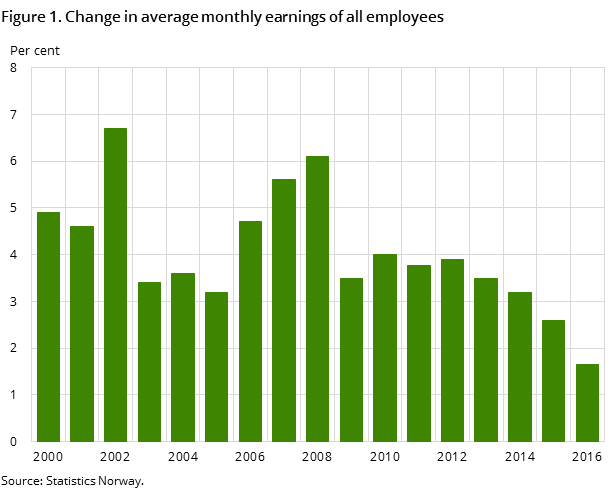
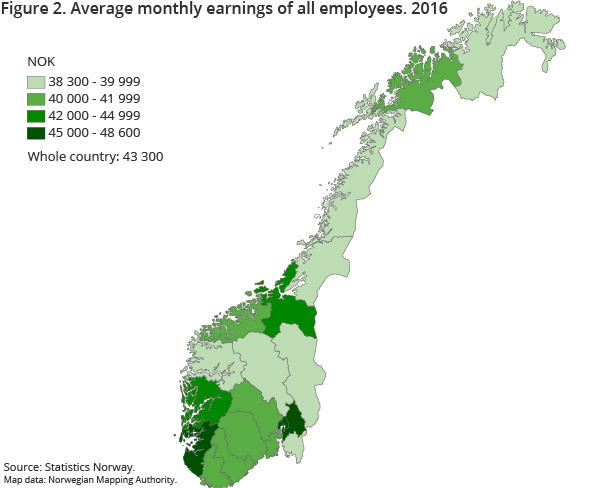
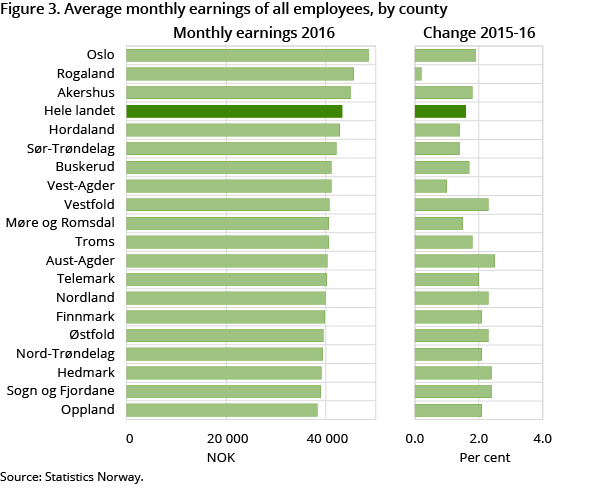
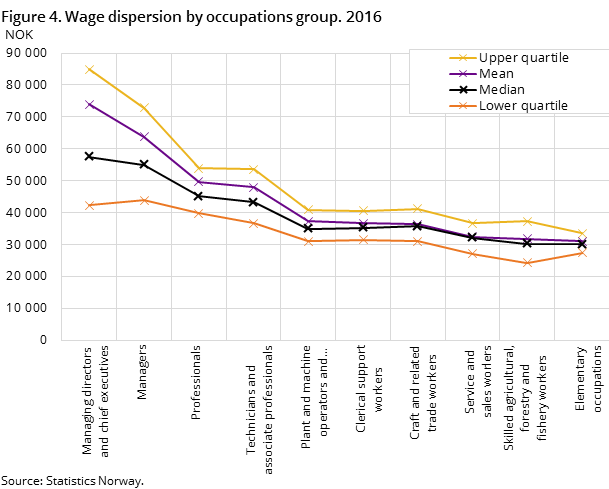
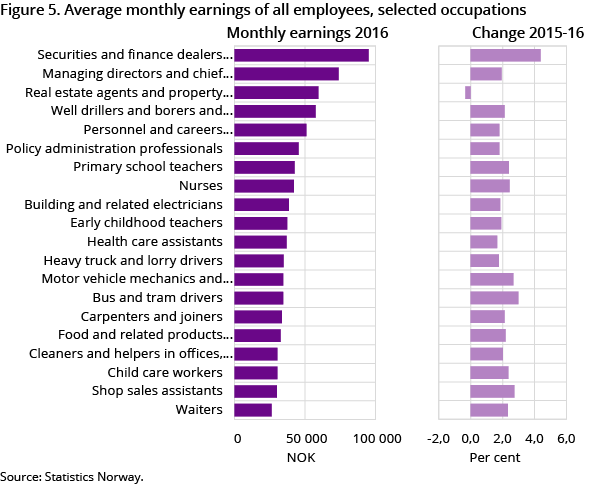
Employees in the private sector had an increase in monthly earnings of 1.4 per cent from NOK 43 200 in 2015 to NOK 43 800 in 2016.
Monthly earnings in the public sector were on average slightly higher, with an increase of 1.8 per cent for employees in central government and 2.3 per cent for employees in municipal and county administration.
The level of monthly earnings in 2016 was NOK 46 500 in central government and NOK 39 500 in municipalities and counties.
Why are the earnings statistics not part of the employment statistics?
The oil and gas extraction industry reduced the overall growth in earnings
Employees in the oil and gas extraction industry had an increase in monthly earnings from NOK 70 100 in 2015 to NOK 71 200 in 2016. This resulted in a wage increase of 1.6 per cent, which is higher than average.
By omitting the oil and gas extraction industry, we can get an estimate on how the industry affects growth in earnings from 2015 to 2016. Overall, the oil and gas extraction industry reduced growth by 0.3 percentage points, so that the overall growth excluding this industry was approximately 1.9 per cent.
For the private sector separately, the effect was about half a percentage point, whereby the wage growth here without the oil and gas extraction industry was also approximately 1.9 per cent.
1.4 per cent growth in earnings for manufacturing employees
Manufacturing employees had an average increase in earnings of 1.4 per cent from 2015 to 2016. The level of earnings increased from an average of NOK 43 800 to NOK 44 400.
There was also a decline in the number of employees in manufacturing as a whole from 2015 to 2016, but due to a lower average level of earnings, manufacturing did not contribute to lower overall growth in earnings for the country in the same way as the oil and gas extraction industry.
Structural changes in the industries have quite a distinct effect on changes in earnings from 2015 to 2016, and give a negative contribution to manufacturing considering the growth in earnings. The greatest decrease in employment can be found in industries with relatively high levels of earnings. For example, reduced activity in machinery and equipment and transport industry (including building of ships and boats) reduced the wage growth in manufacturing to a certain extent.
In the machinery and equipment industry, the monthly earnings were reduced from NOK 49 500 to NOK 49 200, which corresponds to a decrease of 0.6 per cent. In the transport industry, including building of ship and boats, the monthly earnings increased from NOK 47 700 to NOK 48 500, or 1.7 per cent.
Manufacture of food products, beverages and tobacco, had an average wage increase of 2.1 per cent, with no major changes in the number of employees. The wage level increased from NOK 38 900 in 2015 to NOK 39 700 in 2016.
High activity in the building and construction industry
The building and construction industry has the highest growth of earnings among the industries. The average monthly earnings increased from NOK 39 800 in 2015 to NOK 41 000 in 2016, representing a growth of 3.0 per cent.
The increase in number of employees suggests that there is high activity in the industry. The monthly earnings increased by 3.5 per cent to NOK 41 800 in 2016.
For employees in wholesale and retail trade, monthly earnings increased by 2.6 per cent from 2015 to 2016, without major changes in the number of employees or structural changes within the industry. Monthly earnings increased from an average of NOK 37 900 in 2015 to NOK 38 900 in 2016.
In financial services, monthly earnings increased by 3.3 per cent, but in this industry there are major disparities between employees in monetary and insurance intermediation, in relation to employees in other financial intermediation.
For monetary and insurance intermediation, monthly earnings increased from NOK 56 300 in 2015 to NOK 57 700 in 2016, an increase of 2.5 per cent. By comparison, monthly earnings increased by 5.2 per cent to NOK 75 100 in 2016 for employees in other financial intermediation. An increase in average bonus payments of over 17 per cent, or NOK 2 300, also contributed to this growth. In other financial intermediation, we find fund management companies, securities brokerage and other financial activities.
Average monthly earnings for women and men
The average monthly earnings for women as a percentage of men’s monthly earnings increased from 85.3 per cent in 2015 to 86.1 per cent in 2016. Both the private and public sectors saw a reduction in the disparities between women and men's monthly earnings.
In the private sector, monthly earnings for women as a percentage of men’s monthly earnings increased by 0.8 percentage points to 84.6 in 2016.
Within municipalities and county authorities, the average monthly earnings for women as a percentage of men’s monthly earnings increased from 92.9 per cent in 2015 to 93.5 per cent in 2016. In the central government, the increase was 0.8 percentage points to 87.1 per cent.
Rogaland is the county where women have the lowest proportion of men's pay. The average monthly earnings for women in the county was NOK 40 400. The average monthly earnings for men in the county was NOK 49 700. This means that the monthly earnings for women were 81.3 per cent of men’s monthly earnings.
Hedmark is the county with the least inequality between the sexes. In this county, the average monthly earnings for women as a percentage of men’s monthly earnings were 94.7 per cent. Average earnings here were NOK 37 800 for women and NOK 39 900 for men. Generally, counties with higher wage levels also have larger wage disparities between men and women.
The overall increase in monthly earnings for men was 1.3 per cent from NOK 45 600 in 2015 to NOK 46 200 in 2016. In the same period, women's monthly earnings increased by 2.3 per cent from NOK 38 900 to NOK 39 800.
About the statistical basisOpen and readClose
From 2015:
The statistics are based on data from a-meldingen. All employers who have paid out wages, cash payments or salaries in kind, must submit a-melding.
New seriesOpen and readClose
From the year 2015, the stastistics are based on including the whole population, compared to the former method of sampling. New series were therefore created in StatBank Norway at the start of 2015. The use of a new standard of occupation will also lead to a break when comparing with previous years than 2015.
Additional information
Contact
-
Arbeidsmarked og lønn
E-mail: arbeidsmarked@ssb.no
-
Knut Snellingen Bye
E-mail: knut.snellingen.bye@ssb.no
tel.: (+47) 40 81 13 26
-
Magnus Berglund Johnsen
E-mail: magnus.johnsen@ssb.no
tel.: (+47) 40 90 23 75
-
Fredrik Steinrem Edelmann
E-mail: fredrik.edelmann@ssb.no
tel.: (+47) 40 90 24 60
-
Knut Håkon Grini
E-mail: knut.grini@ssb.no
tel.: (+47) 48 20 51 63
